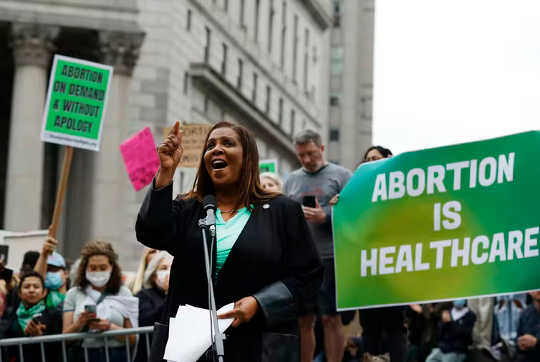
Is The Supreme Court on the cusp of ending Roe v. Wade? AP Photo/Jason DeCrow
A leaked draft suggests the Supreme Court is ready to overturn Roe v. Wade, the landmark case that gave women the right to terminate a pregnancy.
But reproductive health isn’t just about abortion, despite all the attention the procedure gets. It’s also about access to family planning services, contraception, sex education and much else – all of which have also come under threat in recent years.
Such access lets women control the timing and size of their families so they have children when they are financially secure and emotionally ready and can finish their education and advance in the workplace. After all, having children is expensive, typically costing almost US$15,000 a year for a middle-class family. For low-income working families, child care costs alone can eat up over a third of earnings.
And that’s why providing Americans with a full range of reproductive health options is good for the economy, at the same time as being essential to the financial security of women and their families. As a law professor who represents people experiencing poverty, I believe doing the opposite threatens not only the physical health of women but their economic well-being too.
The economics of contraception
A Supreme Court majority acknowledged as much in 1992, stating in its Planned Parenthood of Southeastern Pennsylvania v. Casey decision:
“The ability of women to participate equally in the economic and social life of the nation has been facilitated by their ability to control their reproductive lives.”
But in recent years, the right to control their reproductive health has become increasingly illusory for many women, particularly the poor.
Given their focus on limiting access to abortion, you might assume that conservative politicians would be for policies that help women avoid unintended pregnancies. But conservative attacks on birth control are escalating, even though 99% of sexually active women of reproductive age have used some form of it such as an intrauterine device, patch or pill at least once.
In addition to its widely recognized health and autonomy benefits for women, contraception directly boosts the economy. In fact, research shows access to the pill is responsible for a third of women’s wage gains since the 1960s.
And this benefit extends to their kids. Children born to mothers with access to family planning benefit from a 20% to 30% increase in their own incomes over their lifetimes, as well as boosting college completion rates.
Not surprisingly, in a 2016 survey, 80% of women said birth control had a positive effect on their lives, including 63% reporting that it reduces stress and 56% saying it helps them to keep working.
Disparities in access
Still, there is a class divide in contraception access, as evidenced by disparities in the 2011 rate of unintended pregnancies – the latest data available.
While the overall rate fell to 45% that year from 51% in 2008, the figure for women living at or below the poverty line, although also decreasing, was five times that of women at the highest income level.
One reason for this disparity is the cost of birth control, particularly for the most effective, long-lasting forms. For instance, it typically costs women over $1,000 for an IUD and the procedure to insert it, amounting to about one month’s full-time pay for a minimum-wage worker lacking insurance coverage.
These costs are significant, given that the average American woman will have about two children and will thus need contraception for at least three decades of her life. Unfortunately, publicly funded family planning meets only 54% of the need, and these funding streams are under constant attack by conservatives.
Not surprisingly, health insurance makes a difference, and women with coverage are much more likely to use contraceptive care. And yet about 6.2 million women who need contraception lack insurance coverage.
Further, this coverage can be denied to millions of employees and their dependents who work for employers claiming a religious or moral objection under a Supreme Court ruling in 2020.
Sex education and the economic ladder
Another key to reproductive health – and one that isn’t discussed enough – is sexual education for teenagers.
For years, the public has spent up to $110 million a year on abstinence-only programs, which not only fail to reduce teen birth rates but also reinforce gender stereotypes and are rife with misinformation. Low-income minority teens are particularly subject to these programs.
Teens without knowledge about their sexual health are more likely to get pregnant and less likely to work, spiraling them to the bottom of the economic ladder.
Access to abortion
Then there’s the issue of abortion. Let’s start with the cost.
Half of women who obtain an abortion pay more than one-third of their monthly income for the procedure.
The longer a woman must wait – either because state law requires it or she needs to save up the money, or both – costs rise significantly.
Studies show that women who cannot access abortion are three times as likely to fall into poverty as women who obtained abortions.
In addition to the financial burden, many states are enacting laws designed to limit abortion access. These laws hit low-income women particularly hard. Since Roe was decided, states have enacted 1,320 restrictions on abortion, including waiting periods, mandatory counseling sessions, and onerous restrictions on clinics. In 2021 alone, states passed 90 such laws.
Hyde and health
Another way in which U.S. policy on abortions exacerbates economic inequality, especially for women of color, is through the ban on federal funding.
It has been so since the 1976 enactment of the Hyde Amendment, which prevents federal Medicaid funds from being used for abortions except in cases of rape or incest, or when the life of the mother is at risk.
Denying poor women coverage for abortion under Medicaid contributes to the unintended birth rates that are seven times as high for poor women as for high-income women.
If Roe v. Wade is overturned by the Supreme Court – the chief justice confirmed the leaked draft’s authenticity but said the decision wasn’t final – poor women would be affected the most. Women who are denied abortions are more likely to end up in poverty, be unemployed and turn to public assistance.
By contrast, economists have established that the legalization of abortion led to improved educational, employment and earnings outcomes for women, as well as for their children.
Politicians cannot promise to grow the economy and simultaneously limit access to abortion, birth control and sexual education. America’s economic health and women’s reproductive health are linked.
About The Author
Michele Gilman, Venable Professor of Law, University of Baltimore
This article is republished from The Conversation under a Creative Commons license. Read the original article.
Recommended books:
Capital in the Twenty-First Century
by Thomas Piketty. (Translated by Arthur Goldhammer)
 In Capital in the Twenty-First Century, Thomas Piketty analyzes a unique collection of data from twenty countries, ranging as far back as the eighteenth century, to uncover key economic and social patterns. But economic trends are not acts of God. Political action has curbed dangerous inequalities in the past, says Thomas Piketty, and may do so again. A work of extraordinary ambition, originality, and rigor, Capital in the Twenty-First Century reorients our understanding of economic history and confronts us with sobering lessons for today. His findings will transform debate and set the agenda for the next generation of thought about wealth and inequality.
In Capital in the Twenty-First Century, Thomas Piketty analyzes a unique collection of data from twenty countries, ranging as far back as the eighteenth century, to uncover key economic and social patterns. But economic trends are not acts of God. Political action has curbed dangerous inequalities in the past, says Thomas Piketty, and may do so again. A work of extraordinary ambition, originality, and rigor, Capital in the Twenty-First Century reorients our understanding of economic history and confronts us with sobering lessons for today. His findings will transform debate and set the agenda for the next generation of thought about wealth and inequality.
Click here for more info and/or to order this book on Amazon.
Nature's Fortune: How Business and Society Thrive by Investing in Nature
by Mark R. Tercek and Jonathan S. Adams.
 What is nature worth? The answer to this question—which traditionally has been framed in environmental terms—is revolutionizing the way we do business. In Nature’s Fortune, Mark Tercek, CEO of The Nature Conservancy and former investment banker, and science writer Jonathan Adams argue that nature is not only the foundation of human well-being, but also the smartest commercial investment any business or government can make. The forests, floodplains, and oyster reefs often seen simply as raw materials or as obstacles to be cleared in the name of progress are, in fact as important to our future prosperity as technology or law or business innovation. Nature’s Fortune offers an essential guide to the world’s economic—and environmental—well-being.
What is nature worth? The answer to this question—which traditionally has been framed in environmental terms—is revolutionizing the way we do business. In Nature’s Fortune, Mark Tercek, CEO of The Nature Conservancy and former investment banker, and science writer Jonathan Adams argue that nature is not only the foundation of human well-being, but also the smartest commercial investment any business or government can make. The forests, floodplains, and oyster reefs often seen simply as raw materials or as obstacles to be cleared in the name of progress are, in fact as important to our future prosperity as technology or law or business innovation. Nature’s Fortune offers an essential guide to the world’s economic—and environmental—well-being.
Click here for more info and/or to order this book on Amazon.
Beyond Outrage: What has gone wrong with our economy and our democracy, and how to fix it -- by Robert B. Reich
 In this timely book, Robert B. Reich argues that nothing good happens in Washington unless citizens are energized and organized to make sure Washington acts in the public good. The first step is to see the big picture. Beyond Outrage connects the dots, showing why the increasing share of income and wealth going to the top has hobbled jobs and growth for everyone else, undermining our democracy; caused Americans to become increasingly cynical about public life; and turned many Americans against one another. He also explains why the proposals of the “regressive right” are dead wrong and provides a clear roadmap of what must be done instead. Here’s a plan for action for everyone who cares about the future of America.
In this timely book, Robert B. Reich argues that nothing good happens in Washington unless citizens are energized and organized to make sure Washington acts in the public good. The first step is to see the big picture. Beyond Outrage connects the dots, showing why the increasing share of income and wealth going to the top has hobbled jobs and growth for everyone else, undermining our democracy; caused Americans to become increasingly cynical about public life; and turned many Americans against one another. He also explains why the proposals of the “regressive right” are dead wrong and provides a clear roadmap of what must be done instead. Here’s a plan for action for everyone who cares about the future of America.
Click here for more info or to order this book on Amazon.
This Changes Everything: Occupy Wall Street and the 99% Movement
by Sarah van Gelder and staff of YES! Magazine.
 This Changes Everything shows how the Occupy movement is shifting the way people view themselves and the world, the kind of society they believe is possible, and their own involvement in creating a society that works for the 99% rather than just the 1%. Attempts to pigeonhole this decentralized, fast-evolving movement have led to confusion and misperception. In this volume, the editors of YES! Magazine bring together voices from inside and outside the protests to convey the issues, possibilities, and personalities associated with the Occupy Wall Street movement. This book features contributions from Naomi Klein, David Korten, Rebecca Solnit, Ralph Nader, and others, as well as Occupy activists who were there from the beginning.
This Changes Everything shows how the Occupy movement is shifting the way people view themselves and the world, the kind of society they believe is possible, and their own involvement in creating a society that works for the 99% rather than just the 1%. Attempts to pigeonhole this decentralized, fast-evolving movement have led to confusion and misperception. In this volume, the editors of YES! Magazine bring together voices from inside and outside the protests to convey the issues, possibilities, and personalities associated with the Occupy Wall Street movement. This book features contributions from Naomi Klein, David Korten, Rebecca Solnit, Ralph Nader, and others, as well as Occupy activists who were there from the beginning.
Click here for more info and/or to order this book on Amazon.

























